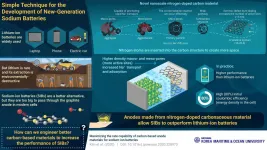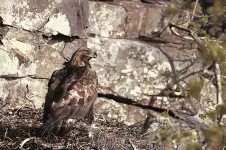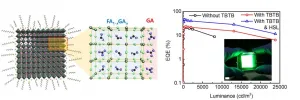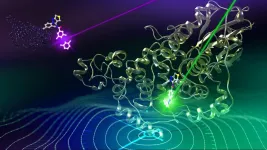Optimal information about the invisible
How do you measure objects that you can't see under normal circumstances? Utrecht University and TU Wien (Vienna) open up new possibilities with special light waves
2021-01-25
(Press-News.org) Laser beams can be used to precisely measure an object's position or velocity. Normally, however, a clear, unobstructed view of this object is required - and this prerequisite is not always satisfied. In biomedicine, for example, structures are examined, which are embedded in an irregular, complicated environment. There, the laser beam is deflected, scattered and refracted, often making it impossible to obtain useful data from the measurement.
However, Utrecht University (Netherlands) and TU Wien (Vienna, Austria) have now been able to show that meaningful results can be obtained even in such complicated environments. Indeed, there is a way to specifically modify the laser beam so that it delivers exactly the desired information in the complex, disordered environment - and not just approximately, but in a physically optimal way: Nature does not allow for more precision with coherent laser light. The new technology can be used in very different fields of application, even with different types of waves, and has now been presented in the scientific journal "Nature Physics".
The vacuum and the bathroom window
"You always want to achieve the best possible measurement accuracy - that's a central element of all natural sciences," says Stefan Rotter from TU Wien. "Let's think, for example, of the huge LIGO facility, which is being used to detect gravitational waves: There, you send laser beams onto a mirror, and changes in the distance between the laser and the mirror are measured with extreme precision." This only works so well because the laser beam is sent through an ultra-high vacuum. Any disturbance, no matter how small, is to be avoided.
But what can you do when you are dealing with disturbances that cannot be removed? "Let's imagine a panel of glass that is not perfectly transparent, but rough and unpolished like a bathroom window" says Allard Mosk from Utrecht University. "Light can pass through, but not in a straight line. The light waves are altered and scattered, so we can't accurately see an object on the other side of the window with the naked eye." The situation is quite similar when you want to examine tiny objects inside biological tissue: the disordered environment disturbs the light beam. The simple, regular straight laser beam then becomes a complicated wave pattern that is deflected in all directions.
The optimal wave
However, if you know exactly what the disturbing environment is doing to the light beam, you can reverse the situation: Then it is possible to create a complicated wave pattern instead of the simple, straight laser beam, which gets transformed into exactly the desired shape due to the disturbances and hits right where it can deliver the best result. "To achieve this, you don't even need to know exactly what the disturbances are," Dorian Bouchet, the first author of the study explains. "It's enough to first send a set of trial waves through the system to study how they are changed by the system."
The scientists involved in this work jointly developed a mathematical procedure that can then be used to calculate the optimal wave from this test data: "You can show that for various measurements there are certain waves that deliver a maximum of information as, e.g., on the spatial coordinates at which a certain object is located."
Take for example an object that is hidden behind a turbid pane of glass: there is an optimal light wave that can be used to obtain the maximum amount of information about whether the object has moved a little to the right or a little to the left. This wave looks complicated and disordered, but is then modified by the turbid pane in such a way that it arrives at the object in exactly the desired way and returns the greatest possible amount of information to the experimental measuring apparatus.
Laser experiments in Utrecht
The fact that the method actually works was confirmed experimentally at Utrecht University: Laser beams were directed through a disordered medium in the form of a turbid plate. The scattering behaviour of the medium was thereby characterised, then the optimal waves were calculated in order to analyse an object beyond the plate - and this succeeded, with a precision in the nano-meter range.
Then the team carried out further measurements to test the limits of their novel method: The number of photons in the laser beam was significantly reduced to see whether one then still gets a meaningful result. In this way, they were able to show that the method not only works, but is even optimal in a physical sense: "We see that the precision of our method is only limited by the so-called quantum noise," explains Allard Mosk. "This noise results from the fact that light consists of photons - nothing can be done about that. But within the limits of what quantum physics allows us to do for a coherent laser beam, we can actually calculate the optimal waves to measure different things. Not only the position, but also the movement or the direction of rotation of objects."
These results were obtained in the context of a program for nanometer-scale imaging of semiconductor structures, in which universities collaborate with industry. Indeed, possible areas of application for this new technology include microbiology but also the production of computer chips, where extremely precise measurements are indispensable.
INFORMATION:
Contact
Prof. Stefan Rotter
Institute for Theoretical Physics
TU Wien
Wiedner Hauptstraße 8-10, 1040 Vienna
+43 1 58801 13618
stefan.rotter@tuwien.ac.at
[Attachments] See images for this press release:
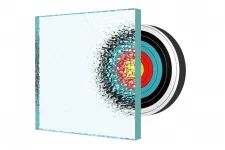
ELSE PRESS RELEASES FROM THIS DATE:
2021-01-25
Depression, especially in urban areas, is on the rise, now more than ever. Mental health outcomes are influenced by, among other things, the type of environment where one lives. Former studies show that urban greenspace has a positive benefit on people experiencing mental ill health, but most of these studies used self-reported measures, which makes it difficult to compare the results and generalise conclusions on the effects of urban greenspace on mental health.
An interdisciplinary research team of UFZ, iDiv and Leipzig University tried to improve this issue by involving an objective indicator: prescriptions of antidepressants. To find out whether a specific type of 'everyday' green space - street trees dotting the neighbourhood sidewalks ...
2021-01-25
A lot is known about galaxies. We know, for instance, that the stars within them are shaped from a blend of old star dust and molecules suspended in gas. What remains a mystery, however, is the process that leads to these simple elements being pulled together to form a new star.
But now an international team of scientists, including astrophysicists from the University of Bath in the UK and the National Astronomical Observatory (OAN) in Madrid, Spain have taken a significant step towards understanding how a galaxy's gaseous content becomes organised into a new generation of stars.
Their findings have important implications for our understanding of how stars formed during the early days of the universe, when galaxy collisions were frequent and dramatic, and star and galaxy formation ...
2021-01-25
Children of mothers experiencing depressive symptoms are more at risk, as adolescents, of experiencing suicidal thoughts and attempting suicide.
New research suggests that this link may be explained by loneliness, potentially opening new ways for youth suicide prevention.
The study - by the universities of Exeter, Montréal, Laval and McGill - used data from more than 1,600 families from the Québec Longitudinal Study of Child Development, a representative sample of new-borns in Quebec followed from birth to 20 years of age.
Mothers were asked about depressive symptoms (such as sadness and losing interest ...
2021-01-25
As the world becomes aware of the imminent environmental crisis, scientists have begun a search for sustainable energy sources. Rechargeable batteries like lithium-ion batteries are seeing a popularity surge, concurrent with production of "greener" technologies such as electric propulsion ships (which are being developed to meet the environmental regulations by the International Maritime Organization) and other electric vehicles. But, lithium is rare and difficult to distribute, putting its sustainability in doubt while also risking sharp increases in cost. Researchers have thus turned ...
2021-01-25
To predict when earthquakes are likely to occur, seismologists often use statistics to monitor how clusters of seismic activity evolve over time. However, this approach often fails to anticipate the time and magnitude of large-scale earthquakes, leading to dangerous oversights in current early-warning systems. For decades, studies outside the seismology field have proposed that these major, potentially devastating seismic events are connected to a range of non-seismic phenomena - which can be observed days or even weeks before these large earthquakes occur. So far, however, this idea hasn't caught on in the wider scientific community. In this special issue, EPJ Special Topics proposes the Global Earthquake Forecasting System (GEFS): the first collaborative initiative ...
2021-01-25
Scientists have shown where bird species would exist in the absence of human activity under research that could provide a new approach to setting conservation priorities.
A study by Durham University, UK, in collaboration with the Royal Society for the Protection of Birds (RSPB), investigated how human activities such as agriculture, deforestation, and the drainage of wetlands have shaped where bird species are found in Great Britain today.
Researchers used data on the geographical distributions of bird species alongside simulation models to predict where bird species would exist today if the effects of human activities on the landscape were removed.
In this scenario there were winners ...
2021-01-25
Public health researchers, led by UNSW Sydney, have estimated the number of cancer cases requiring surgery globally each year, predicting the number will rise from 9.1 million to 13.8 million from 2018 to 2040 - an increase of 52 per cent or 4.7 million cases.
Their research shows the greatest relative increase will occur in 34 low-income countries, where the number of cases requiring surgery is expected to more than double by 2040 (314,355 cases to 650,164, or 107 per cent).
The modelling study, published in The Lancet Oncology on Friday, analysed global demand for cancer surgery and estimated surgical and anaesthesia ...
2021-01-25
Research team at Seoul National University (Prof. Tae-Woo Lee) and University of Pennsylvania (Prof. Andrew M. Rappe) developed perovskite light-emitting diodes (PeLEDs) with an external quantum efficiency (EQE) of 23.4%. The research results were published in Nature Photonics, which is the world-renowned international academic journal, on January 4th (Title: Comprehensive defect suppression in perovskite nanocrystals for high-efficiency light-emitting diodes).
Metal halide perovskites have very narrow spectral emission, excellent color purity, low material cost, and wide and easy color-tunability. ...
2021-01-25
The Nagoya University Institute of Transformative Bio-Molecules (WPI-ITbM) research team of Designated Associate Professor Tsuyoshi Hirota, Postdoctoral Fellow Simon Miller, Professor Kenichiro Itami and graduate student Tsuyoshi Oshima (Research Fellowship for Young Scientists, JSPS), in collaboration with the group of Professor Ben Feringa and Postdoctoral Fellow Dušan Kolarski of Groningen University in the Netherlands, have achieved a world first: fully reversible manipulation of the period of the circadian clock using light, by exchanging part of a compound with a light-activated switch.
Waking in the ...
2021-01-25
Greater sports participation among Aboriginal and Torres Strait Islander children is linked with better academic performance, according to new research from the University of South Australia.
Conducted in partnership with the University of Sydney and the University of Technology Sydney, the world-first study found that Aboriginal and Torres Strait Islander children who played organised sports every year over four years, had numeracy skills which were advanced by seven months, compared to children who did less sport.
The study used data from four successive waves of Australia's Longitudinal Study of Indigenous Children, following 303 students (with a baseline age of five to six years old) to assess cumulative sports participation against ...
LAST 30 PRESS RELEASES:
[Press-News.org] Optimal information about the invisible
How do you measure objects that you can't see under normal circumstances? Utrecht University and TU Wien (Vienna) open up new possibilities with special light waves



